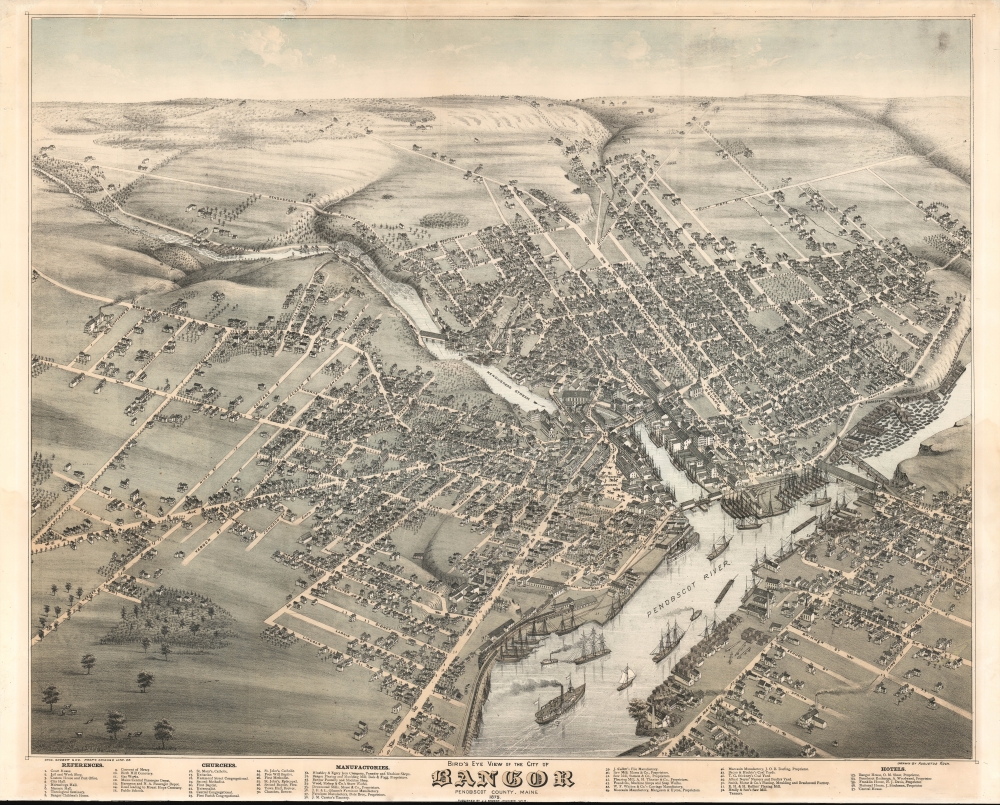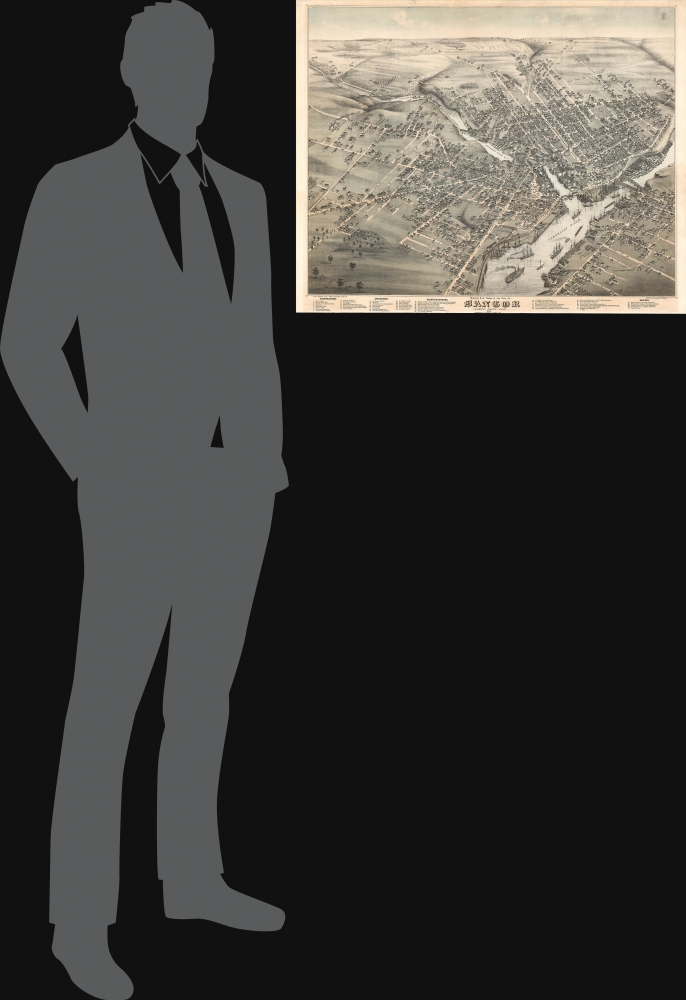This item has been sold, but you can get on the Waitlist to be notified if another example becomes available, or purchase a digital scan.
1875 Augustus Koch Bird's-Eye View of Bangor, Maine (Stoner)
BangorMaine-stoner-1875-2
Title
1875 (dated) 25.5 x 31 in (64.77 x 78.74 cm)
Description
A Closer Look
Koch presents a high-oblique perspective view of Bangor, from a fictional high-point to the south, looking north. This style, for which Koch is much admired, combines the best qualities of a bird's-eye view and a map. The Franklin, Central, and State Street Bridges over the Kenduskaeg Stream form the central focal point. Some 57 civic buildings, hotels, churches, and business are identified with a numeric key at the base of the map. Koch had an engineer's passion for accuracy that is very much on display here - even the names of the ships, 'The City of Richmond' and 'Kayandon,' among others, were known Bangor vessels.Historical Context
In 1875, Bangor, Maine, was one of the world's foremost lumber ports, with fortunes tied to the timber industry. Situated strategically on the Penobscot River, the 'Queen City of the East' served as a bustling hub where logs, cut from the vast North Maine Woods, were transported and processed. Amidst the clatter of sawmills and the bustling waterfront, Bangor's population witnessed a period of growth and prosperity. Lumber barons built grand mansions showcasing their wealth, but the city also faced the challenges of rapid industrialization, including socio-economic disparities and environmental concerns. Bangor's significance in the lumber trade was such that it was often said that Bangor's sawmills could produce enough shingles to shingle the world.American Bird's-Eye City Views
The Bird's-Eye view industry emerged in the United States in the middle part of the 19th century and coincided with the commercial development of lithographic printing. Before the rise of lithography, the ability to own and display artwork in the home was largely limited to the extremely wealthy, but the advent of lithographic printing made it possible for everyone to own visually striking artwork. A robust trade developed in portraits of political leaders, allegorical and religious images, and city views.City views were being produced in the United States as early as the 1830s, but the genre exploded after the American Civil War (1861 - 1865). Bridging the gap between maps and pictures, most 19th century American bird's-eye views presented cities to the public from highpoints. Some were imagined, but others were drawn from hot-air balloons or nearby hills. The presentation, combining high elevation, commercial interest, and new printing technology created a uniquely American artform, as described by historian Donald Karshan,
Some print connoisseurs believe that it was only with the advent of the full-blown city-view lithograph that American printmaking reached its first plateau of originality, making a historical contribution to the graphic arts. They cite the differences between the European city-view prints and the expansive American version that reflects a new land and a new attitude toward the land.The vogue for bird's-eye city views lasted from about 1845 to 1920, during which period some 2,400 cities were thus portrayed, some multiple times. Although views were produced in many urban centers, the nexus of view production in the United States was Milwaukee, Wisconsin. The major American viewmakers were Stoner, Wellge, Bailey, Fowler, Hill Ruger, Koch, Burleigh, Norris, and Morse, among others.
Chromolithography
Chromolithography, sometimes called oleography, is a color lithographic technique developed in the mid-19th century. The process involved using multiple lithographic stones, one for each color, to yield a rich composite effect. Oftentimes, the process would start with a black basecoat upon which subsequent colors were layered. Some chromolithographs used 30 or more separate lithographic stones to achieve the desired product. Chromolithograph color could also be effectively blended for even more dramatic results. The process became extremely popular in the late 19th and early 20th centuries when it emerged as the dominant method of color printing. The vivid color chromolithography produced made it exceptionally effective for advertising and propaganda imagery.Publication History and Census
This view was drawn by Augustus Koch and published by J. J. Stoner. It was printed by Charles Shober and Company, Lithographers, Chicago. Today Koch's view of Bangor is extremely rare with only four known examples surviving in institutional collections.CartographerS
Augustus Koch (October 15, 1834 - 1901), active in the late 19th century, was one of the most prolific and widely traveled artists specializing in American city bird's-eye views. Koch was born in Birnbaum, Germany where, according to his superior officers in the Engineers Office of the Wisconsin Infantry during the Civil War, he received an excellent education. Some have speculated that he may have immigrated to the United States young and been educated here, but this seems unlikely as he retained a very strong German accent throughout his life. Koch enlisted as a private in the Wisconsin regiment during the American Civil War. He applied and was approved for an officer's commission in 1863. He was assigned as engineering officer to one of the black regiments serving in the Lower Mississippi Valley. There is produced several maps including one of Vicksburg. Koch started producing bird's-eye views after the Civil War with his first published view, Cedar Falls, Iowa, appearing around 1868. Koch may have apprenticed with Albert Ruger, another important Wisconsin view maker, and it may have been Ruger who introduced him to Joseph Stoner, who published many of his most significant views. According to John W. Reps, in Views and Viewmakers of Urban America (Page185),
Koch drew his cities with considerable care, consistently depicting his subjects as if seen from very high viewpoints. The horizon lines appear close to the tops of the images, and the body of each print is thus full of urban detail. Koch also used a distinctive format, making his horizontal dimension not much greater than the vertical.The date of Koch's death is unknown. His career saw the publication of some 110 views in at least 23 different states. More by this mapmaker...
Joseph John Stoner (December 21, 1829 - May 1917) was a Madison, Wisconsin based publisher of bird's-eye city views active in the late 19th and early 20th centuries. Stoner was born in Highspire, Pennsylvania and apprenticed as a carver of ornamental chairs before turning to publishing. He partnered with the bookseller Ephraim T. Kellogg of Madison, Wisconsin, for whom he was a traveling agent. His career in views began around 1867 when he met and befriended the bird's-eye view artist Albert Ruger, who was sketching Madison that year. Ruger and Stoner partnered and began publishing city views under the imprint 'Ruger & Stoner.' The partners traveled extensively through the Midwest publishing some 11 city views under their joint imprint - although there may be as many as 62 others unattributed. The partnership partially dissolved in 1872 although they continued to work together on a contractual basis. Stoner subsequently traveled even more extensively, hiring young artists to sketch city views in such wide ranging destinations as Texas, Maine, and Oregon, among others. He produced a total of some 314 views with various artists including: Albert Ruger, Herman Brosius, Thaddeus M. Fowler, Augustus Koch, Albert F. Poole, Henry Wellge, Joseph Warner, and Camille N. Drie (Dry). Stoner died in Berkeley, California in 1917. Learn More...
Charles Shober (February 1831 - c. 1900) was a German-American lithographer and painter. Shober was born in Germany and immigrated to the United States in 1854. He established himself in Philadelphia, at 17 Minor Street, where fellow lithographers and map engravers George Worley and Benjamin Mathias, also worked. His first lithograph in America appeared in an 1855 issue of The Horticulturist. In 1857, he partnered with Charles Reen to establish 'Reen and Shober' at 5 South Sixth Street, Philadelphia. The partners relocated their business to Chicago (106 Lake Street) in 1859. Reen left the firm in 1859 and Charles took a new partner, August Roth, printing under the imprint of 'Charles Shober'. They met with considerable success, until 1871, when like many Chicago businesses, the Great Fire laid them low. After the fire, he took over management and partial ownership of the Chicago Lithographic Company, which had been founded some years earlier by Louis Kurtz and Edward Carqueville. Kurtz's interest in the firm was acquired by Shober and it was renamed 'Charles Shober and Company'. Sometime after 1876, the firm's name changed to 'Shober Lithograph Company', and then in 1877, to 'Shober and Carqueville Lithograph Company'. Despite infighting, the firm prospered, printing views, posters, maps, trade cards, and sheet music. In 1887, after a prolonged dispute with Carqueville, Shober left the firm. He traveled briefly then took a position as president of the Chicago Bank Note Company. Shober's son died in a tragic suicide in 1896, after which, Shober seems to have vanished from professional life. He appears in the Chicago directory as late as 1900. Learn More...




